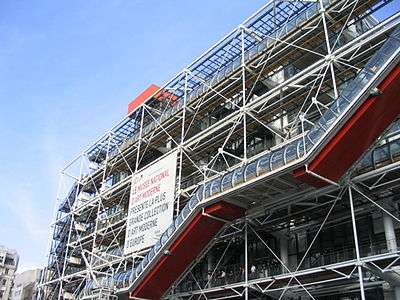Bowellism
Bowellism is a modern style of architecture heavily associated with Richard Rogers.
The premise is that the services for the building, such as ducts, sewage pipes and lifts, are located on the exterior to maximise space in the interior. The style originated with Michael Webb's 1957 student project for a Furniture Manufacturers Association building in High Wycombe.[1][2][3] Webb coined the term in response to a comment on his design by Sir Nikolaus Pevsner in a 1961 lecture, in which he recalled hearing the words: "within the schools there are some disturbing trends; I saw the other day a design for a building that looked like a series of stomachs sitting on a plate. Or bowels, connected by bits of bristle".[4] Thus this inside-out style was termed 'Bowellism' because of how it recalled the way the human body works.
Richard Rogers and Renzo Piano continued the style with the design of the Pompidou Centre in Paris, described as a "vast exercise in Bowellism",[5] so the floor space of the interior could be maximised to fully appreciate the exhibitions.[6]
Examples
- The Pompidou Centre in Paris (1977) by Rogers and Renzo Piano.
- The Lloyd's building in London (1978) also by Rogers.
- The Central Library of Rotterdam (1983) by Jaap Bakema.
Gallery
 Pompidou Centre, Paris
Pompidou Centre, Paris Lloyd's building, London
Lloyd's building, London Rotterdam Library, Rotterdam
Rotterdam Library, Rotterdam
References
- ↑ Geoffrey Howard Baker, The Architecture of James Stirling and His Partners James Gowan and Michael Wilford: A Study of Architectural Creativity in the Twentieth Century, Farnham, Surrey / Burlington, Vermont: Ashgate, 2011, ISBN 9781409409267, p. 158.
- ↑ Radical Post-Modernism, ed. Charles Jencks, FAT, Architectural Design 81.5, Profile 213, Hoboken, New Jersey: Wiley, 2011, ISBN 978-0-470-66988-4, p. 107.
- ↑ Simon Sadler, Archigram: Architecture Without Architecture, Cambridge, Massachusetts: MIT, 2005, p. 23, 1.11, 1.12 caption, calling bowellism a "micromovement".
- ↑ Samantha Hardingham and David Greene, The disreputable projects of David Greene, Architectural Association Publications 2007-10-01, OCLC 811429228, pdf Archived December 17, 2013, at the Wayback Machine. p. 44.
- ↑ Jonathan Richards, Facadism, London: Routledge, 1994, ISBN 9780415083164, p. 60.
- ↑ Richard Rogers, Architects, From Here to Modernity, archived at the Wayback Machine, 15 March 2004.